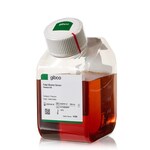Search Thermo Fisher Scientific

Certificates
SDS
Citations & References (33)
Gibco™
Fetal Bovine Serum, qualified, United States
Important Update: We've recently introduced Premium Fetal Bovine Serum (FBS) specification-based products. These improved products are alternatives to our Qualified US origin SKUs. Product stability, performance, manufacturing, storage, and transport processes are unchanged.
| Catalog Number | Quantity | Format |
|---|---|---|
| 26140079 | 500 mL | Bottle |
| A3160501 | 50 mL | One Shot |
| A3160502 | 10 x 50 mL | One Shot |
Our improved Premium Fetal Bovine Serum (FBS) features enhanced specifications with unchanged stability, manufacturing, storage, and transport processes.

Fetal Bovine Serum (FBS), Premium, bottle, 500 mL
Catalog number: A5670701
In stock
Catalog number 26140079
Gibco fetal bovine sera offer excellent value for basic cell culture, specialty research, and specific assays, earning the trust of researchers with consistent quality and award-winning support that helps meet your research needs and budget requirements
Gibco Sera: Trusted Quality for Consistent Performance
Gibco Sera Category: Value Plus (Performance)
- Use for general cell culture with common cell lines
- Low endotoxin and hemoglobin levels
- Endotoxin level: <10 EU/mL
- Hemoglobin level: <25 mg/dL
- Origin: United States
Gibco Serum Delivers
- ISO 13485 certified, processed in FDA registered facilities
- Triple filtered at 0.1 μm
- Gibco bottle is easier to use in the hood, reduces the risk of contamination and helps you perform cell culture more consistently
- Peel-off sticker on label provides handy reference for lot number and expiration date recording in lab notebook
For research use or further manufacturing use only. Serum and blood proteins are not for direct administration into humans or animals.
Specifications
Endotoxin Concentration≤10 EU/mL
Hemoglobin Concentration≤25 mg/dL
Purity or Quality GradeQualified
Shipping ConditionFrozen
SpeciesCattle/Bovine
AgeFetal
Country of OriginUnited States
FormLiquid
FormatBottle
Product TypeFetal Bovine Serum
Quantity500 mL
Serum TreatmentStandard (Sterile-filtered)
SterilitySterile
Sterilization MethodTriple-filtered, 0.1 μm
Unit SizeEach
Contents & Storage
Storage conditions: ≤-10°C
Shipping conditions: Frozen
Shipping conditions: Frozen
Have questions about this product? Ask our AI assisted search.
This is an AI-powered search and may not always get things right. You can help us make it better with a thumbs up or down on individual answers or by selecting the “Give feedback" button. Your search history and customer login information may be retained by Thermo Fisher and processed in accordance with our
Privacy Notice.
Frequently asked questions (FAQs)
Figures

Consistency of HEK293 Cell Growth in Gibco® FBS:
Customers who viewed this item also viewed
Documents & Downloads
Certificates
Search by lot number or partial lot number
Lot #Certificate TypeDateCatalog Number(s)
U3241226RPCertificate of AnalysisJun 21, 202526140079, 26140087, 26140095
U3126623PCertificate of AnalysisMar 30, 202526140079, 26140087, 26140095
U3129988PCertificate of AnalysisFeb 20, 202526140079, 26140087, 26140095
U3129988PCertificate of AnalysisFeb 20, 2025A3160502, A3160501
U3116590PCertificate of AnalysisFeb 14, 2025A3160502, A3160501
5 results displayed, search above for a specific certificate
Safety Data Sheets
SDS
Scientific Resources
Citations & References (33)
Search citations by name, author, journal title or abstract text
Citations & References
Abstract
A functional role for the B56 alpha-subunit of protein phosphatase 2A in ceramide-mediated regulation of Bcl2 phosphorylation status and function.
Journal:J Biol Chem
PubMed ID:11929874
'Recently it has been shown that the potent apoptotic agent ceramide activates a mitochondrial protein phosphatase 2A (PP2A) and promotes dephosphorylation of the anti-apoptotic molecule Bcl2 (Ruvolo, P. P., Deng, X., Ito, T., Carr, B. K., and May, W. S. (1999) J. Biol. Chem. 274, 20296-20300). In cells expressing Bcl2,
Metabolism of 4 beta -hydroxycholesterol in humans.
Journal:J Biol Chem
PubMed ID:12077124
'One of the major oxysterols in the human circulation is 4 beta-hydroxycholesterol formed from cholesterol by the drug-metabolizing enzyme cytochrome P450 3A4. Deuterium-labeled 4 beta-hydroxycholesterol was injected into two healthy volunteers, and the apparent half-life was found to be 64 and 60 h, respectively. We have determined earlier the half-lives
Activation of retinoic acid receptor-dependent transcription by all-trans-retinoic acid metabolites and isomers.
Journal:J Biol Chem
PubMed ID:12070176
'We have shown that four metabolites of all-trans-retinoic acid (ATRA) (4-oxo-, 4-OH-, 18-OH-, and 5,6-epoxy-RA) can induce maturation of NB4 promyelocytic leukemia cells (Idres, N., Benoit, G., Flexor, M. A., Lanotte, M., and Chabot, G. G. (2001) Cancer Res. 61, 700-705). To better understand the mechanism of action of ATRA
Interaction of human breast fibroblasts with collagen I increases secretion of procathepsin B.
Journal:J Biol Chem
PubMed ID:12072442
'Interactions of stromal and tumor cells with the extracellular matrix may regulate expression of proteases including the lysosomal proteases cathepsins B and D. In the present study, we determined whether the expression of these two proteases in human breast fibroblasts was modulated by interactions with the extracellular matrix component, collagen
A ligand-inducible epidermal growth factor receptor/anaplastic lymphoma kinase chimera promotes mitogenesis and transforming properties in 3T3 cells.
Journal:J Biol Chem
PubMed ID:11919185
'Oncogenic rearrangements of the anaplastic lymphoma kinase (ALK) gene, encoding a receptor type tyrosine kinase, are frequently associated with anaplastic large cell lymphomas. Such rearrangements juxtapose the intracellular domain of ALK to 5''-end sequences belonging to different genes and create transforming fusion proteins. To understand how the oncogenic versions of
33 total citations